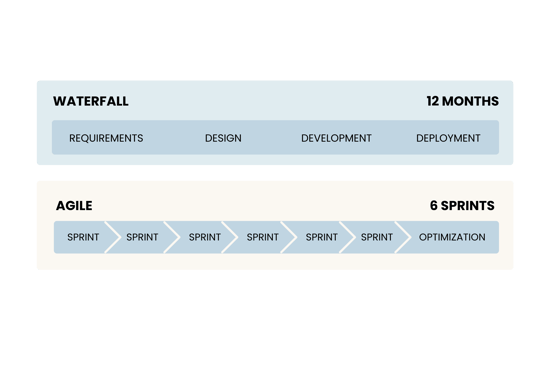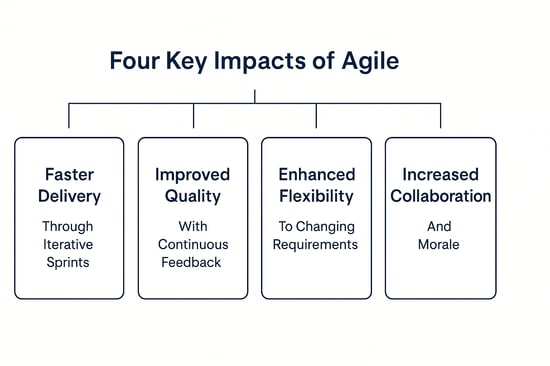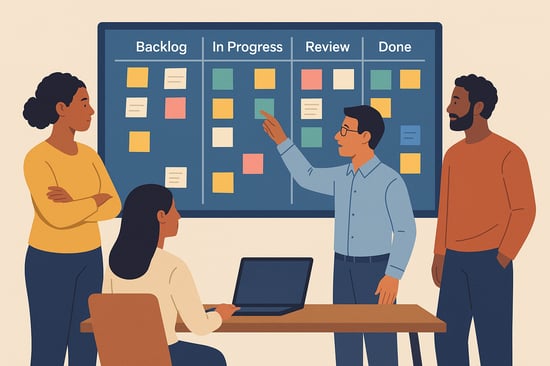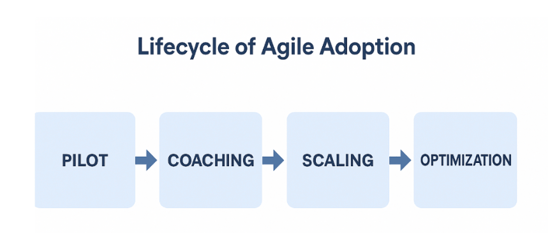The Impact of Agile Methodologies on Project Timelines and Outcomes
The Impact of Agile Methodologies on Project Timelines and Outcomes
Introduction
In today’s fast-paced IT environment, traditional project methodologies often fall short. The waterfall model is sequential, plan-heavy, and rigid which works well when requirements are stable. But in a digital first world where policy changes, tech disruptions, and user expectations evolve rapidly, the waterfall’s long delivery cycles often lead to over budget, outdated, or misaligned outcomes¹.
Agile methodologies emerged as a response. Introduced formally with the Agile Manifesto in 2001, Agile favors iterative development, customer collaboration, and responsiveness to change. By breaking projects into 2 to 4 week sprints, Agile enables frequent delivery of working software, allowing early feedback and adjustment².
The results are clear:
- 71% of Agile adopters report faster time-to-market³
- 60% fewer defects in Agile-developed solutions⁴
- 30% higher customer satisfaction for Agile organizations⁵
In public sector IT, Agile is gaining ground: 80% of U.S. federal projects now use Agile or iterative methods, up from 10% a decade ago⁶. The Deloitte Center for Government Insights notes Agile has improved delivery speed, responsiveness, and collaboration in complex agency projects⁶.
Despite its strengths, Agile isn’t plug and play. Misunderstood implementations or organizational resistance often derail initiatives. That’s where expert partners like ICM Solutions help organizations maximize Agile's benefits while avoiding its pitfalls.
How Agile Improves Timelines and Outcomes
1. Faster Delivery Through Iterative Sprints
Agile’s sprint based model delivers working software early and often. Instead of waiting 12 months for a fully integrated release (as with waterfall), stakeholders can start using functional components in 3 to 6 weeks.
For example, when developing a government procurement portal, an Agile team can deliver login functionality in Sprint 1, basic search in Sprint 2, and vendor registration in Sprint 3. This means users can start testing and giving feedback months before the final release.
According to the State of Agile report, 52% of organizations adopt Agile to accelerate delivery³. In fast moving domains like fintech or e-health, early delivery offers a competitive or policy-driven edge.

2. Improved Quality Through Continuous Feedback
Agile builds quality into every sprint. Instead of waiting until the end to test, Agile teams use:
- Automated testing (e.g., Selenium, JUnit)
- Sprint reviews with real users
- Daily QA feedback loops
One Forrester study found Agile teams had 60% fewer post-release defects⁴. By testing and reviewing each increment, teams resolve issues early which avoids costly rework and enhancing user experience.
This is especially critical in public services (e.g., benefits eligibility tools or tax portals), where errors in production can disrupt services or compliance.
3. Greater Flexibility to Evolving Requirements
Agile welcomes change. Sprint planning happens every 2 to 3 weeks, allowing product owners to reprioritize features based on:
- Policy shifts
- Market feedback
- Technical discoveries
In waterfall, mid-course changes often delay timelines. In Agile, they’re built into the process. This flexibility is essential in industries like healthcare, where a new regulatory requirement could appear mid-project.
In a Deloitte study, 78% of public-sector leaders said Agile helped them respond more effectively to evolving requirements⁶.
4. Stronger Team Collaboration and Morale
Agile teams work in cross-functional, co-located (or virtually connected) groups. Daily stand-ups, retrospectives, and collaborative planning increase:
- Visibility
- Ownership
-
Team satisfaction

Harvard Business Review found Agile teams had 20% higher morale than traditional teams⁵. They also report stronger stakeholder relationships, since product owners are engaged throughout development.
In our experience, retention improves and teams deliver more innovative solutions when Agile is adopted thoughtfully.

Common Challenges in Agile Adoption
While Agile is powerful, success is not automatic. Key pitfalls include:

According to McKinsey, only 30% of Agile transformations succeed at scale without expert intervention⁷.
How ICM Solutions Can Help
At ICM Solutions, we don’t just teach Agile, we implement it with measurable results. Our services focus on customization, training, practical execution, and ongoing improvement.
1. Tailored Agile Frameworks
No two organizations are alike. We assess your goals and workflows to recommend a framework:
- Scrum: Time-boxed sprints for structured development
- Kanban: Continuous flow for operations/support teams
- SAFe/Hybrid: For scaling Agile across large programs
We ensure Agile fits your governance, compliance, and technical environment not the other way around.
Example: A financial regulator needed to integrate Agile without disrupting oversight audits. We built checkpoints and compliance mapping into their Scrum ceremonies, satisfying both agility and accountability.
2. Expert Training and Coaching
Our certified Agile coaches offer:
- Role-specific training for developers, POs, execs
- Simulation workshops to reinforce best practices
- Embedded coaching during first sprints
Training helps teams adopt not just Agile rituals, but the mindset of iterative learning and shared ownership. In a recent engagement, our coaching helped a healthcare IT team improve productivity by 40% in 2 months.
3. Delivering Proven Results
We bring deep experience across sectors:
.png?width=550&height=367&name=WP13%20(1).png)
In all cases, we use tools like Jira or Azure DevOps to provide full transparency to stakeholders overall, boosting trust and velocity.
4. Long-Term Support and Optimization
Agile success grows over time. ICM Solutions offers:
- Agile maturity assessments
- Agile Center of Excellence (CoE) setup
- Scaling strategies for multiple teams/programs
We ensure Agile becomes a resilient core capability in your organization, not a short-term experiment.

Agile methodologies deliver faster timelines, better outcomes, and stronger alignment with stakeholder needs. For organizations under pressure to do more with less, especially in government and regulated industries, Agile offers a sustainable path forward.
But Agile done poorly can lead to chaos. That’s why ICM Solutions is the partner of choice for IT leaders seeking to implement Agile the right way which is strategically, practically, and measurably.
Let’s talk. Whether you’re planning a digital transformation or need help rebooting a stuck project, ICM Solutions can help.
Contact us to schedule a free Agile readiness consultation.
Visit our blog to explore case studies, frameworks, and additional insights.
Sources
McKinsey & Co. (2023). Why agile product delivery outpaces traditional models
Agile Manifesto. (2001). Agile Principles
Digital.ai. (2023). 17th Annual State of Agile Report
Forrester. (2022). The Business Impact of Agile
Harvard Business Review. (2021). Why Agile Teams Are Happier and More Productive
Deloitte. (2017). Agile by Design: Government Transformation
McKinsey. (2020). The five trademarks of agile organizations

